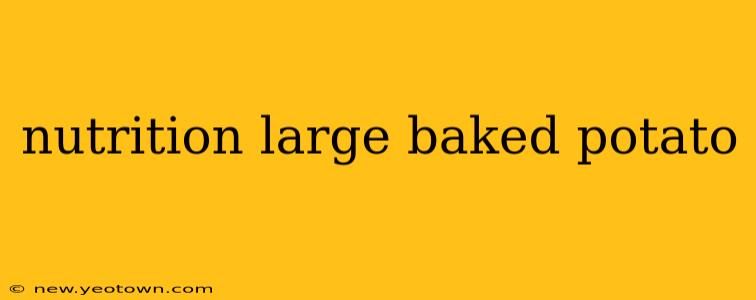The humble baked potato. Often overlooked, dismissed as a simple side dish, it's time to give this nutritional powerhouse its due. Far from being a dietary villain, a large baked potato, prepared simply, offers a surprising array of vitamins, minerals, and fiber that contribute significantly to a balanced diet. Let's delve into the delicious details.
What are the Nutritional Benefits of a Large Baked Potato?
A large baked potato (roughly 5.3 ounces or 150 grams) packs a nutritional punch. Think of it as a blank canvas, ready to be adorned with your favorite toppings, but even on its own, it's a nutritional star. We're talking significant amounts of potassium, vitamin C, vitamin B6, and dietary fiber, all crucial for various bodily functions. This starchy vegetable is surprisingly low in fat and sodium, making it a healthy choice for many.
How Many Calories are in a Large Baked Potato?
Calorie content can vary slightly depending on the size and preparation method, but a large baked potato typically contains around 161 calories. It's important to remember that this is without any additions. Toppings like butter, sour cream, cheese, and bacon can significantly increase the calorie count. So, mindful topping choices are key to maintaining the potato's health benefits.
Is a Baked Potato Good for Weight Loss?
This is a question that often sparks debate. The answer? It can be! A plain baked potato is relatively low in calories and high in fiber, which promotes satiety – that feeling of fullness – helping you feel satisfied with a smaller portion of food. However, the addition of high-calorie toppings can quickly negate these benefits. So, for weight loss, focus on healthy toppings like salsa, chili, or a sprinkle of herbs and spices.
What are the Best Toppings for a Baked Potato?
This is where personal preference reigns supreme! But focusing on nutrient-rich toppings enhances the potato's health profile. Think vibrant vegetables like broccoli, spinach, or chives; lean protein such as grilled chicken or black beans; and healthy fats like a drizzle of olive oil. Avoid excessive amounts of butter, sour cream, or cheese to keep the calorie and fat content in check.
Are Baked Potatoes Healthy for Diabetics?
This requires a nuanced approach. While baked potatoes are a good source of fiber, which can help regulate blood sugar levels, they are also relatively high on the glycemic index (GI). This means they can cause a rapid spike in blood sugar. Portion control is vital, and pairing the potato with healthy fats and proteins can help to moderate this glycemic response. Always consult with your doctor or a registered dietitian for personalized dietary advice if you have diabetes.
How Can I Make a Healthy Baked Potato?
The beauty of a baked potato lies in its simplicity. Scrub the potato clean, pierce it with a fork (to prevent steam build-up and potential explosion!), and bake it in the oven at 400°F (200°C) for about an hour, or until tender. Avoid adding excessive oil or butter during the baking process. Let your creativity shine with healthy toppings afterward!
In conclusion, the large baked potato is far from a dietary villain. It’s a versatile and nutritious food, offering a range of vitamins, minerals, and fiber. By making smart choices about toppings and portion control, you can enjoy this humble spud as part of a healthy and balanced diet. So, next time you're looking for a satisfying and nutritious meal, don't overlook the power of the humble baked potato!

